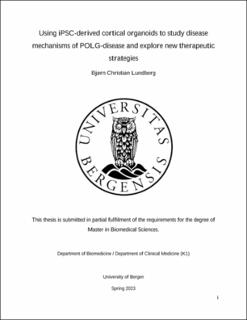| dc.description.abstract | POLG-related diseases are a set of severe mitochondrial myopathies caused by a mutation in the POLG gene. The POLG gene encodes for the catalytic subunit of the mitochondrial DNA (mtDNA) polymerase gamma (Pol-γ). Pol-γ is responsible for the replication and maintenance of mtDNA, and dysfunction of Pol-γ due to mutations in the POLG gene leads to mtDNA depletion and an accumulation of mtDNA deletions over time. This impairment of the mtDNA leads to dysfunctions in the mitochondrial respiratory chain, leading to severe cellular energy depletion as a result of reduced adenine triphosphate (ATP) production. POLG-related diseases have a large degree of variance in the age that symptoms manifest and the severity of the symptoms. POLG-related diseases manifest mainly in postmitotic tissues such as those of the brain, skeletal muscle and liver, and mutations in the POLG gene have been associated with several disorders such as Alpers-Huttenlocher syndrome (AHS), progressive external ophthalmoplegia (PEO), and childhood myocerebrohepatopathy syndrome (MCHS). POLG-related disorders often manifest severe neurological symptoms, and there are currently no effective treatments available for POLG-diseases. One of the main challenges in conducting studies of POLG-related disease is the limited availability of patient tissues available for study. To overcome this challenge, we have in this study developed a method for generating cortical organoids (COs) from patient derived induced pluripotent stem cells (iPSCs). In this study we have generated COs from iPSCs from a patient carrying the mutations p.Ala467Thr and p.Trp748Ser, known to be associated with several POLG-related neurodegenerative disorders including AHS. In this thesis we attempt to determine the ability of generated POLG COs to accurately model the phenotypic features of POLG-disease, as well as an initial investigation into nicotinamide riboside (NR) as a potential novel therapeutic treatment option. We discovered distinct differences in the growth patterns of POLG COs, notably a tendency for POLG COs to fuse together in culture at a far greater rate than the control. Flow cytometry analysis also revealed POLG COs had lowered cell viability, and overall decreased expression of markers indicating depletion of neuronal mass, loss of mitochondrial mass, complex I (C1) depletion and loss of mtDNA volume. However, when normalizing the mitochondrial mass to the neuronal mass, and normalizing mtDNA volume and C1 to the mitochondrial mass a reduction was no longer observed. NR supplementation was seen to have a rescuing effect on the POLG COs, increasing cell viability and increasing expression of markers indicating increased overall neuronal mass, mitochondrial mass, C1 and mtDNA. But the same trend was not observed in normalized values. This study is part of our preliminary investigations into the utilization of COs as a potential modeling system for POLG-related disease, as such this study was conducted on a limited number of repeats and lacks any statistical analysis. Therefore, it is important to keep in mind that these are preliminary findings, and that further investigation is required to confirm if these findings are significant. Furthermore, the methodology revealed a certain degree of limitations including difficulties with imaging, variable staining efficiency, and an overall low viable cell population throughout samples showing that there is still a need to improve and optimize our protocols. However, the findings of this study have given valuable insight into the cellular impacts of POLG mutations and serve as a foundation for further research in this field. In conclusion, this study has opened a new frontier in the study of POLG and other mitochondrial diseases and holds promise for the development of novel therapeutic strategies. | |
